The cloud-busting natural giants of our planet, mountains were formed millions of years ago by intense tectonic activity. Whether admired from afar or scaled on intrepid adventures, their enormity and mysticism inspire intrigue and wonder for travelers. When it comes to the tallest mountains in the United States, one state in particular dominates the list: the “Great Land” of the Far North. Alaska’s 665,000 square miles are home to many of the highest-reaching peaks in the country, but not all of them. Below, explore the 14 tallest mountains in the United States.
Mount Elbert – Colorado (14,440 Feet)
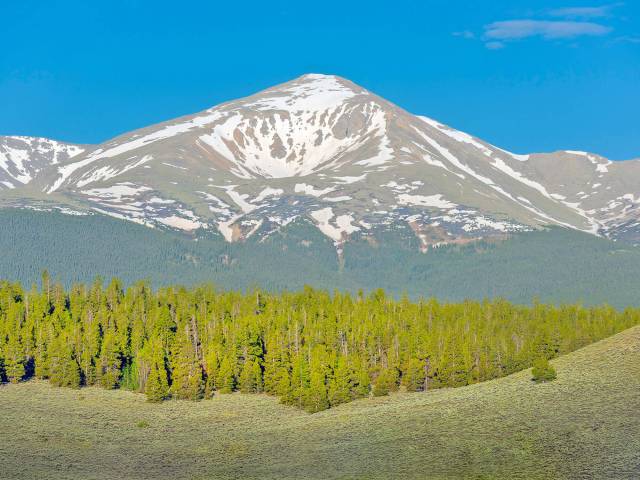
Part of the Sawatch Range in the Rocky Mountains, Mount Elbert is the tallest of Colorado’s 58 “14ers,” a local nickname for all the state’s mountains that reach above 14,000 feet. The second-tallest peak in the lower 48 states, Mount Elbert was named after Governor Samuel H. Elbert, who famously never set foot on the slopes. Two main routes lead to the summit, the 4.8-mile-long North Elbert Trail and 5-8-mile-long South Elbert Trail. If you’re looking to hike to Elbert’s peak, June to September is the best time to climb.
University Peak – Alaska (14,470 Feet)
Tucked away in Wrangell-St. Elias National Park, the nation’s largest national park, University Peak is a seldom-climbed mountain notable for its rugged slopes and icy glaciers. Taking its name from the University of Alaska, the peak is often considered a southern outlier of nearby Mount Bona. Steep-ridged slopes and the potential for avalanches make ascending the mountain a challenge even for experienced climbers and ski mountaineers. The reward for those who make the arduous journey is an uninterrupted panorama of the Alaskan backcountry.
Mount Alverstone – Alaska (14,500 Feet)

At the southwestern border of Alaska and Canada’s Yukon territory, Mount Alverstone shares a massif with Mount Hubbard and Mount Kennedy (Canada). Also known as Boundary Peak 180, Alverstone is located within the St. Elias Mountains. The peak is named after Lord Richard Everard Webster Alverstone, who cast the deciding vote in the Alaska Boundary Dispute in the early 20th century. Explorer and geographer Walter Wood made the first recorded climb of the peak in 1951. He also ascended Mount Hubbard on the same trip.
Mount Whitney – California (14,494 Feet)
Mount Whitney is the highest peak in California, as well as the entire contiguous United States. Located within the Sierra Nevada mountains, it rises above Sequoia National Park and Inyo National Forest. The shortest route to the top is via a 10.7-mile trail starting at Whitney Point, but, due to the peak’s popularity, hikers must first obtain one of the limited available permits. Interestingly, Mount Whitney is only 85 miles from Death Valley’s Badwater Basin, which is the lowest point in North America.
Mount Hunter – Alaska (14,583 Feet)

Located in Denali National Park, Mount Hunter is the third-largest mountain of the Alaskan Range. It’s called Begguya in the Indigenous Dena’ina language, which means “child of Denali.” Characterized by sheer faces and ice ridges, it’s considered one of the most arduous and technical climbs in North America. Both the summit and base of Mount Hunter, which meets the 44-mile-long Kahiltna Glacier, are covered in ice. In 1954, climbers Fred Beckey and Heinrich Herrer reached the top of Mount Hunter and Denali in the same season.
Mount Bear – Alaska (14,829 Feet)
Enveloped by the icy wilderness of the St. Elias Range five miles from the Canadian border, Mount Bear is the true definition of isolation. The icy plateaus of this lofty peak are part of the Barnard and Klutlan Glaciers. Rated as a non-technical climb, Mount Bear is an ideal expedition for first-time mountaineers. The multi-day trek explores uncrowded slopes and spectacular views of ice-clad summits. Skiers can also tackle a 6,000-foot trail from the top.
Mount Hubbard – Alaska (14,950 Feet)
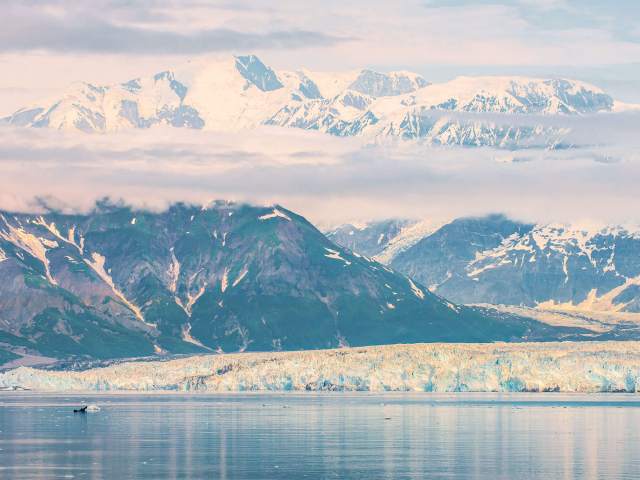
Straddling the Alaska-Yukon border, Mount Hubbard has sections located in two national parks: Canada’s Kluane National Park and America’s Wrangell-St. Elias National Park. Geologist Israel Russell named the peak after Gardiner Green Hubbard, president of the National Geographic Society, who co-sponsored Russell’s expeditions. Climbers attempting to scale the mountain typically approach it from the east side, which requires less technical skill. The peak rises 11,000 feet above Hubbard Glacier, the longest tidewater glacier in North America.
Mount Fairweather – Alaska (15,325 Feet)
Another mountain close to the Alaska-Canada border, Mount Fairweather is one of the world’s tallest coastal mountains. This pyramid-shaped peak lies within Glacier Bay National Park. Captain James Cook reportedly named the peak because of the good weather he experienced during his visit here. On clear days, Mount Fairweather is visible from up to 70 miles away. The first successful summit ascent was in 1931, and only 43 other attempts have been completed since. Visitors can catch a glimpse of the mountain on boat tours and cruises around Glacier Bay.
Mount Sanford – Alaska (16,237 Feet)
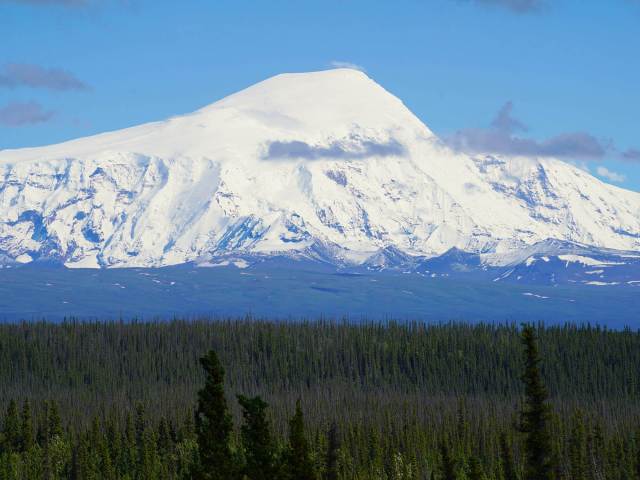
Dominating the skyline of the northern tip of the Wrangell Mountains is the Mount Sandford shield volcano. The last recorded eruption took place during the Pleistocene epoch, which is Earth’s most recent ice age. Although Mount Sanford is rarely studied and climbed, backcountry adventurers have been known to tackle the mountain’s long north ridge. Several observation points are scattered around the Glennallen area of Wrangell-St. Elias National Park, including pullouts on the Glenn Highway and Tok Cutoff Highway.
Mount Blackburn – Alaska (16,390 Feet)
The tallest peak in the Wrangell Mountains, Mount Blackburn makes a daunting impression with its massive icefields, craggy ridges, and crevassed glaciers. It’s the principal source of Kennicott Glacier, located above the historic ghost town of Kennicott. A combination of the height and proximity to the Gulf of Alaska creates treacherous weather conditions around this shield volcano; as a result, summit climbs are uncommon. Husband and wife team George Handy and Dora Keen completed the first ascent of Mount Blackburn in 1912. They traveled up the east ridge, which wasn’t successfully climbed again until over 60 years later.
Mount Bona – Alaska (16,421 Feet)
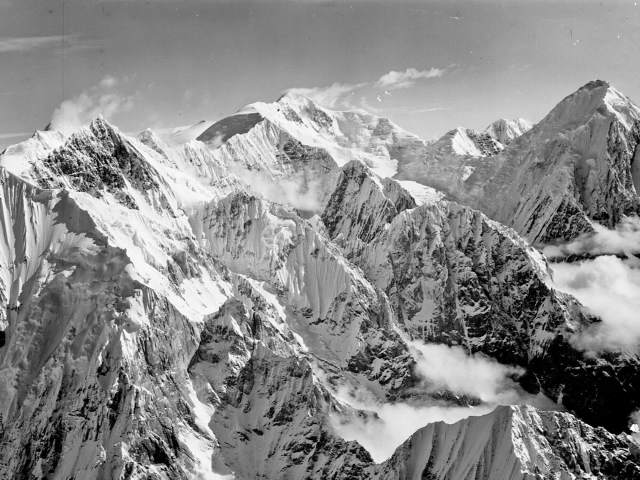
Mount Bona is a stratovolcano in the St. Elias Mountains that last erupted in 847 CE. Resulting from this eruption were the sprawling ice fields and glaciers that cover the mountain today, including the 26-mile-long Russell Glacier and 22-mile-long Hawkins Glacier. Various wildlife species inhabit the area around the mountain, namely black and grizzly bears, caribou, moose, and mountain goats. Italian mountaineer Prince Luigi Amedeo di Savoia named the peak after his racing yacht. He spotted it during his ascent of nearby Mount St. Elias in 1897.
Mount Foraker – Alaska (17,402 Feet)
Soaring over Denali National Park, Mount Foraker is the second-tallest mountain in the Alaska Range. According to reports, the Tanana Athabaskan peoples called the mountain both Sultana (“the woman”) and Menlale (“Denali’s wife”). The mountain’s north and south peaks were both first climbed in 1934. Despite this, few climbers make the ascent today. This is primarily because the permit grants access to Foraker and neighboring Denali, with most opting to visit the latter.
Mount St. Elias – Alaska (18,008 Feet)
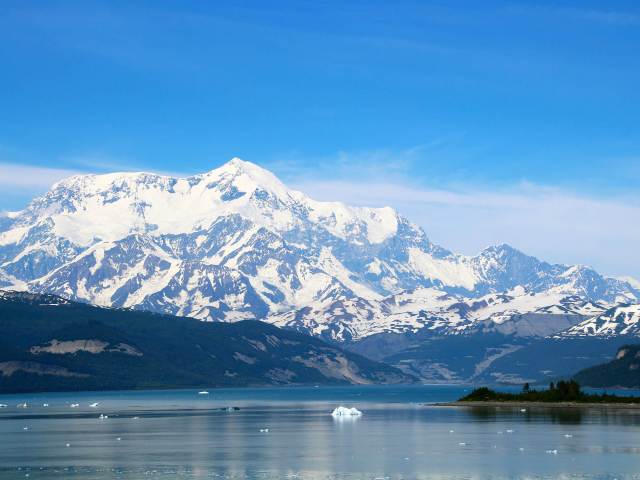
Mount St. Elias is the second-tallest mountain in both the United States and Canada. Straddling the border between the two countries, this behemoth holds great cultural and spiritual importance among the Tlingit peoples. They call it Was’eitushaa (“mountain at the head of Ice Bay”) and regard it as a spirit that takes care of the people. While extreme weather conditions make Mount St. Elias all but off-limits to human climbers, many animals find shelter here. They include caribou, moose, and mountain goats, which can climb to 10,000 feet.
Denali – Alaska (20,310 Feet)
Breaking through the clouds in the 6-million-acre Denali National Park, Denali (formerly known as Mount McKinley) is the country’s tallest peak. Its name comes from the Koyukon language and translates to “the High One.” The climb to the top of Denali is famously challenging and requires specialist glacier and team rope skills. Other thrill-seeking adventures available around Denali include skiing on the slopes above Ruth Glacier. Denali is also rich in wildlife, and one particularly fascinating species is the Dall sheep, whose cloven hooves help them access high-altitude areas.
Featured image credit: 1111IESPDJ/ iStock
More from our network
Daily Passport is part of Optimism, which publishes content that uplifts, informs, and inspires.























